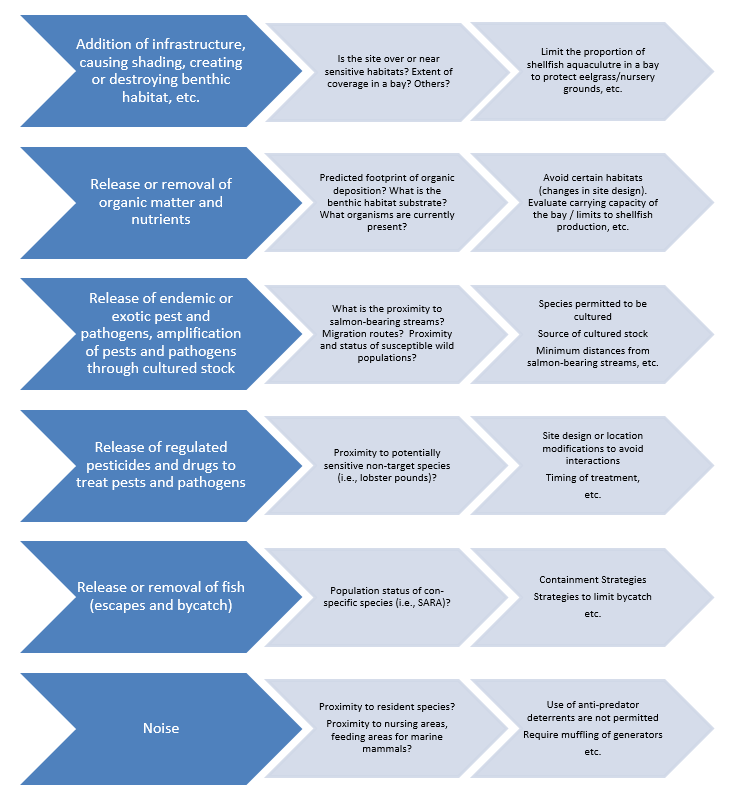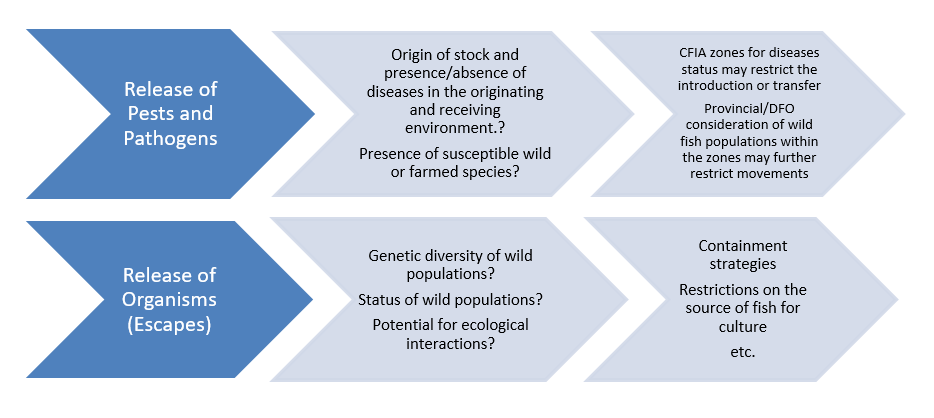Framework for Aquaculture Risk Management: Application of the aquaculture Pathways of Effects in aquaculture activities decisions
Introduction
The Framework for Aquaculture Risk Management (FARM) describes a structured and transparent process by which Fisheries and Oceans Canada (DFO) will be conducting and communicating the assessment of risk from aquaculture activities and the selection of measures to reduce this risk to a level that will meet the Department’s sustainable development and conservation and protection goals. Decisions and advice related to the management of aquaculture are considered prior to the establishment of a site, prior to significant changes to an existing site, prior to the movement of fish to an aquaculture facility, and in evaluating the operational performance of aquaculture facilities.
As part of the implementation of the FARM, new policies and more formal risk management strategies will be developed (see the associated document, Framework for Aquaculture Risk Management for a description of the framework and planned initial polices and strategies).
Pre-site or pre-change assessments
Prior to the establishment of a new aquaculture facility or significant changes to an existing aquaculture facility, the provincial, territorial and federal governments require the aquaculture industry to submit information for assessment as part of the leasing and licensing process.
Regardless of where the new or expanded facility is located, DFO considers the following stressors and effects in determining the advice regarding risks that the proposed activity poses to the environment and ecosystem. The specific stressor-effect relationships are characterized as the Aquaculture Pathways of Effects (see the accompanying document Overview of the Aquaculture Pathways of Effects Tool for Assessing Aquaculture Impacts for details, or the DFO Science Advisory ReportFootnote 1).
Therefore, the broad threshold for unacceptable harm to fish or fish habitat is any aquaculture activity that is anticipated to cause population-level detrimental effects to fish populations. However, in making specific aquaculture decisions, the management objective is to avoid, minimize and mitigate effects on fish and fish habitat well below this threshold (i.e. at an “intervention threshold” analogous to the upper stock reference point of the Sustainable Fisheries Framework). Considerations include local environmental conditions, status of local populations, the scale and intensity of the activity, and predicted effects on habitats, particularly those that have specific functions for fish populations (i.e., nursery grounds, spawning grounds, forage grounds, etc). This level of harm avoidance is analogous to fishery harvest control rules and avoiding the lower stock reference point in managing fish stocks, which if exceeded may result in population impactsFootnote 2. It is also aligned with the avoidance of population level effects for managing species at riskFootnote 3.
The assessments and risk management strategies applied prior to the establishment of an aquaculture facility are critical to avoiding impacts on fish and fish habitat. Through proper siting, many stressor-effects can be avoided. Those that remain may then be mitigated through operational or site-specific requirements, and the acceptable impacts may then be evaluated by comparing operational performance monitoring results to regulatory thresholds.
All of the stressor-effects relationships should be evaluated at the pre-site stage. Figure 1 outlines the stressor and associated effects, examples of considerations and questions posed as part of the pre-site assessment, and examples of options for risk management and mitigation.

Long description
Addition of infrastructure, causing shading, creating or destroying benthic habitat, etc. Is the site over or near sensitive habitats? Extent of coverage in a bay? Others? Limit the proportion of shellfish aquaculture in a bay to protect eelgrass/nursery grounds, etc.
Release or removal of organic matter and nutrients. Predicted footprint of organic deposition? What is the benthic habitat substrate? What organisms are currently present? Avoid certain habitats (changes in site design). Evaluate carrying capacity of the bay / limits to shellfish production, etc.
Release of endemic or exotic pests and pathogens, amplification of pests and pathogens through cultured stock. What is the proximity to salmon-bearing streams? Migration routes? Proximity and status of susceptible wild populations? Species permitted to be culture. Source of cultured stock. Minimum distances from salmon-bearing streams, etc.
Release of regulated pesticides and drugs to treat pests and pathogens. Proximity to potentially sensitive non-target species (i.e., lobster pounds)? Site design or location modification to avoid interactions. Timing of treatment, etc.
Release or removal of fish (escapes and bycatch). Population status of con-specific species (i.e., SARA)? Containment strategies. Strategies to limit bycatch etc.
Noise. Proximity to resident species? Proximity to nursing areas, feeding areas for marine mammals? Use of anti-predator deterrents are not permitted. Require muffling of generators, etc.
Introductions and transfer of fish to an aquaculture facility
As part of aquaculture site and stock management activities, aquaculture facilities request permission to introduce or transfer fish stock to their sites. These requests are evaluated by the Introductions and Transfers Committee under the National Code on Introductions and Transfers of Aquatic Organisms. The regulatory authority for these evaluations is s.56 of the Fishery (General) Regulations. The Canadian Food Inspection Agency is the competent authority for aquatic animal health under the Health of Animals Act.

Long description
Release of pests and pathogens. Origin of stock and presence/absence of diseases in the originating and receiving environment.?[sic] Presence of susceptible wild or farmed species? CFIA zones for diseases status may restrict the introduction or transfer. Provincial/DFO consideration of wild fish populations within the zones may further restrict movements.
Release of organisms (escapes). Genetic diversity of wild populations? Status of wild populations? Potential for ecological interactions? Containment strategies. Restrictions on the source of fish for culture. Etc.
Operational performance monitoring, thresholds and reporting requirements
Aquaculture activities will produce some level of impact, much of which would have been considered at the pre-site assessment stage. The remaining impacts are then permitted, with the application of site-specific mitigation measures. Operational performance monitoring provides information on whether or not the predicted impact is above or below the regulatory threshold. Regulatory auditing of aquaculture practices allows for the assessment of compliance with mitigation measures and can inform on the efficacy of these measures to limit the effects.
The data collected as part of operational performance monitoring and other regulatory reporting requirements are important sources of data that can inform adaptive management approaches for aquaculture. This data can permit the evaluation of the validity of the assumptions and estimations made during the pre-site assessment and the efficacy of site-specific mitigation measures in protecting fish and fish habitat. As well, it can be incorporated into the identification of issues and the need for future science advice, as well as in subsequent aquaculture decisions related to operations and site assessments.
Currently, the only national, federal operational regulatory threshold that is used in the management of aquaculture in Canada is the organic deposition threshold to limit the scale and impact of the deposit of feed and faeces from marine finfish farms, as defined in the Aquaculture Activities Regulations.
In addition, there are fish health management and reporting requirements that are defined by the provincial regulatory authority. Details on the reporting requirements for aquaculture in British Columbia can be found in the Pacific Aquaculture Regulations, in Conditions of Licence and online.
The National Aquaculture Public Reporting Data provides information submitted to the DFO by industry owners or operators as a reporting requirement under the Aquaculture Activities Regulations and can be found online.
- Date modified: